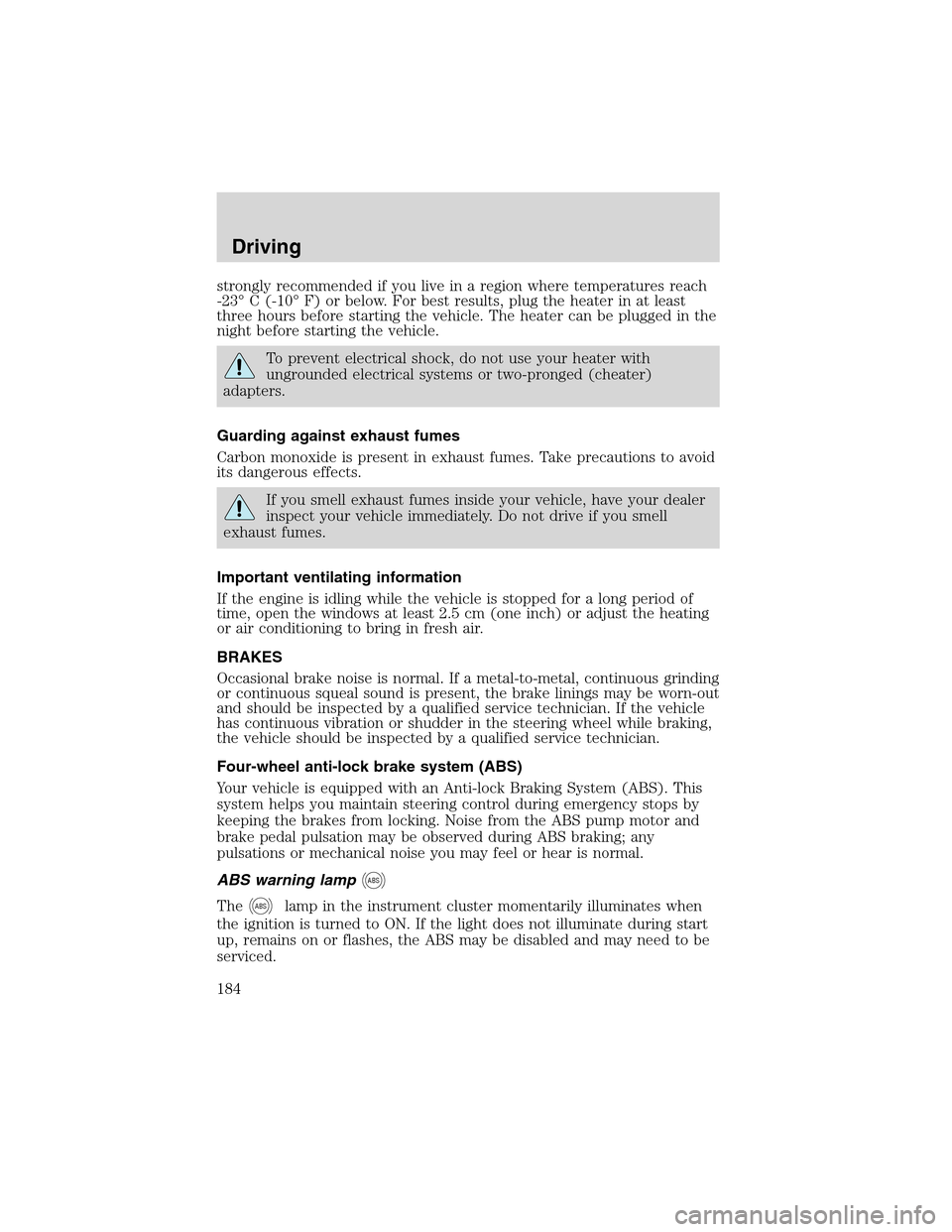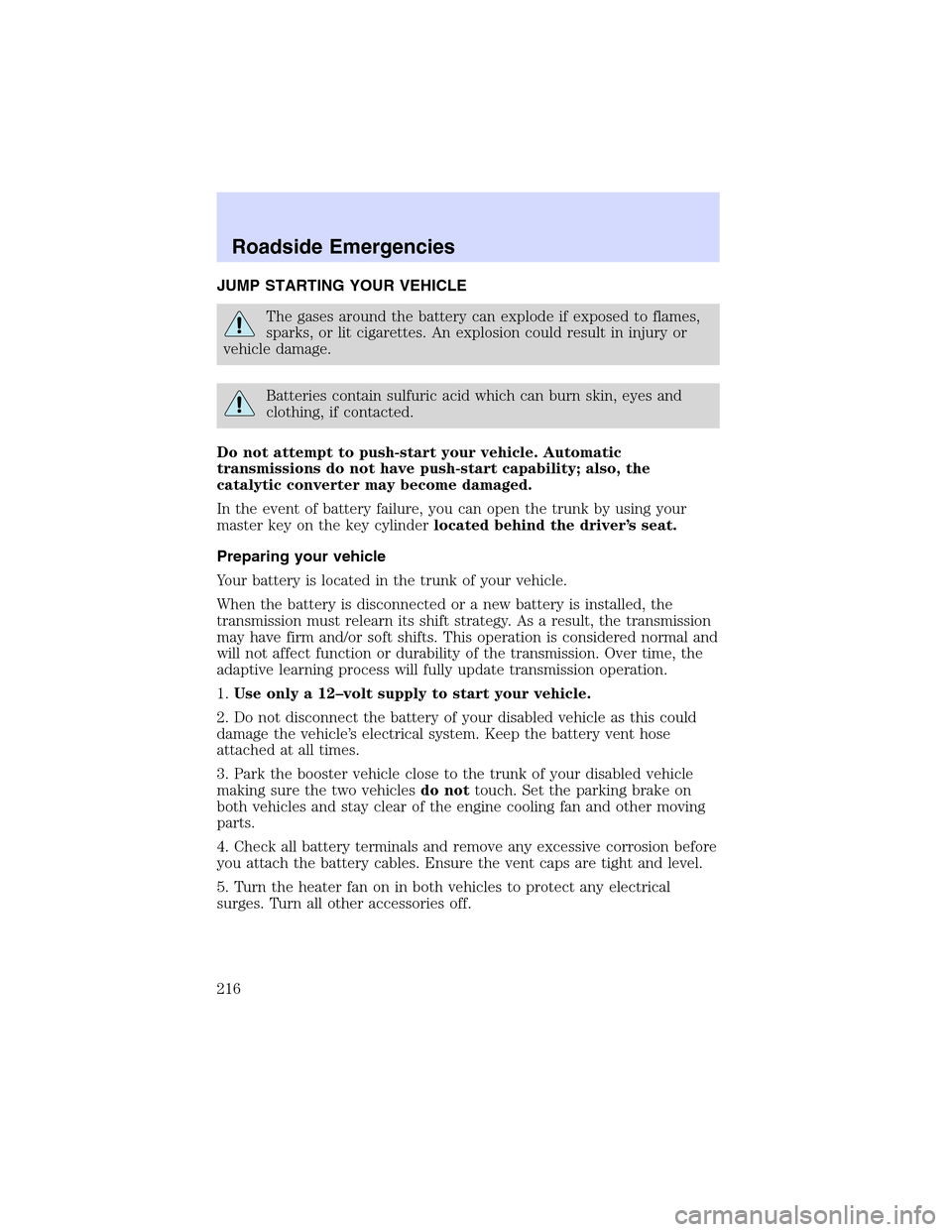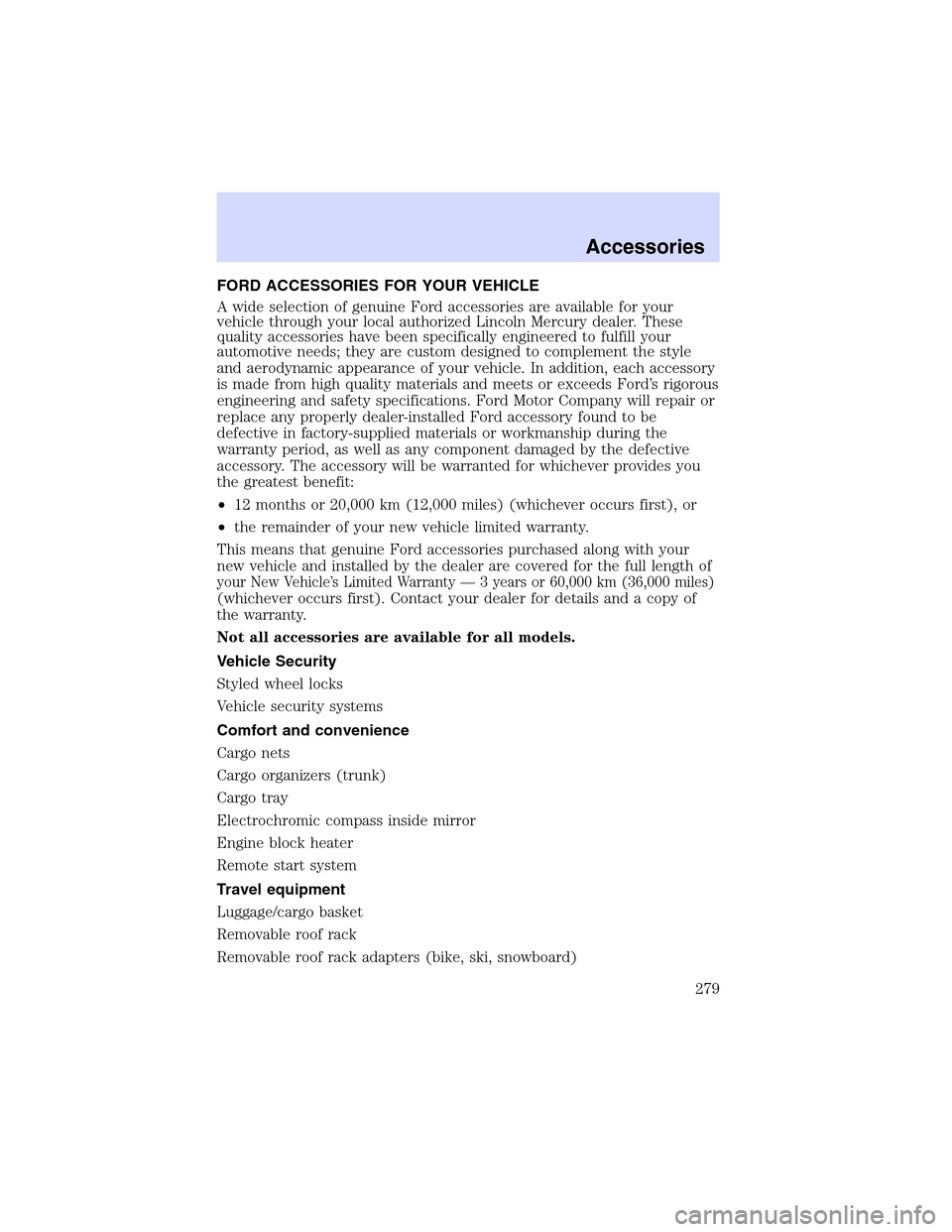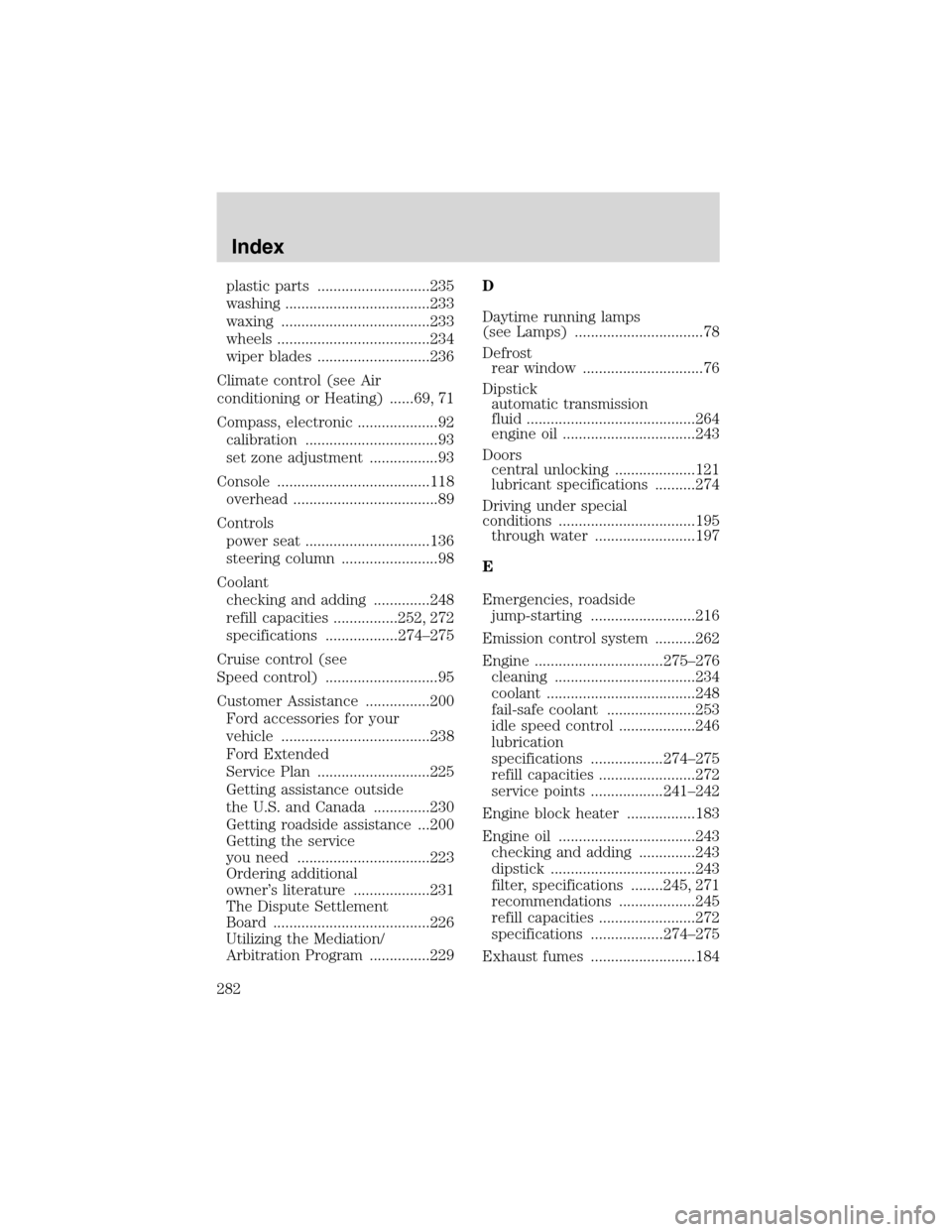2003 LINCOLN LS heater
[x] Cancel search: heaterPage 183 of 288

•Turnthekey to 4 (ON) without
turning the key to 5 (START).
Make sure the corresponding lights illuminate or illuminate briefly. If a
light fails to illuminate, have the vehicle serviced.
•If the driver’s safety belt is fastened, the
light may not illuminate.
Starting the engine
1. Turn the key to 4 (ON) without
turning the key to 5 (START). If
there is difficulty in turning the key,
rotate the steering wheel until the
key turns freely. This condition may
occur when:
•the front wheels are turned
•a front wheel is against the curb
Turn the key to 5 (START), then release the key as soon as the engine
starts. Excessive cranking could damage the starter.
Note:If the engine does not start within five seconds on the first try,
turn the key to 3 (OFF), wait 10 seconds and try again.
Using the engine block heater (if equipped)
An engine block heater warms the engine coolant which aids in starting
and heater/defroster performance. Use of an engine block heater is
23 1
4
5
2
3
4
5
1
Driving
183
Page 184 of 288

strongly recommended if you live in a region where temperatures reach
-23°C (-10°F) or below. For best results, plug the heater in at least
three hours before starting the vehicle. The heater can be plugged in the
night before starting the vehicle.
To prevent electrical shock, do not use your heater with
ungrounded electrical systems or two-pronged (cheater)
adapters.
Guarding against exhaust fumes
Carbon monoxide is present in exhaust fumes. Take precautions to avoid
its dangerous effects.
If you smell exhaust fumes inside your vehicle, have your dealer
inspect your vehicle immediately. Do not drive if you smell
exhaust fumes.
Important ventilating information
If the engine is idling while the vehicle is stopped for a long period of
time, open the windows at least 2.5 cm (one inch) or adjust the heating
or air conditioning to bring in fresh air.
BRAKES
Occasional brake noise is normal. If a metal-to-metal, continuous grinding
or continuous squeal sound is present, the brake linings may be worn-out
and should be inspected by a qualified service technician. If the vehicle
has continuous vibration or shudder in the steering wheel while braking,
the vehicle should be inspected by a qualified service technician.
Four-wheel anti-lock brake system (ABS)
Your vehicle is equipped with an Anti-lock Braking System (ABS). This
system helps you maintain steering control during emergency stops by
keeping the brakes from locking. Noise from the ABS pump motor and
brake pedal pulsation may be observed during ABS braking; any
pulsations or mechanical noise you may feel or hear is normal.
ABS warning lamp
ABS
TheABSlamp in the instrument cluster momentarily illuminates when
the ignition is turned to ON. If the light does not illuminate during start
up, remains on or flashes, the ABS may be disabled and may need to be
serviced.
Driving
184
Page 216 of 288

JUMP STARTING YOUR VEHICLE
The gases around the battery can explode if exposed to flames,
sparks, or lit cigarettes. An explosion could result in injury or
vehicle damage.
Batteries contain sulfuric acid which can burn skin, eyes and
clothing, if contacted.
Do not attempt to push-start your vehicle. Automatic
transmissions do not have push-start capability; also, the
catalytic converter may become damaged.
In the event of battery failure, you can open the trunk by using your
master key on the key cylinderlocated behind the driver’s seat.
Preparing your vehicle
Your battery is located in the trunk of your vehicle.
When the battery is disconnected or a new battery is installed, the
transmission must relearn its shift strategy. As a result, the transmission
may have firm and/or soft shifts. This operation is considered normal and
will not affect function or durability of the transmission. Over time, the
adaptive learning process will fully update transmission operation.
1.Use only a 12–volt supply to start your vehicle.
2. Do not disconnect the battery of your disabled vehicle as this could
damage the vehicle’s electrical system. Keep the battery vent hose
attached at all times.
3. Park the booster vehicle close to the trunk of your disabled vehicle
making sure the two vehiclesdo nottouch. Set the parking brake on
both vehicles and stay clear of the engine cooling fan and other moving
parts.
4. Check all battery terminals and remove any excessive corrosion before
you attach the battery cables. Ensure the vent caps are tight and level.
5. Turn the heater fan on in both vehicles to protect any electrical
surges. Turn all other accessories off.
Roadside Emergencies
216
Page 279 of 288

FORDACCESSORIES FOR YOUR VEHICLE
A wide selection of genuine Ford accessories are available for your
vehicle through your local authorized Lincoln Mercury dealer. These
quality accessories have been specifically engineered to fulfill your
automotive needs; they are custom designed to complement the style
and aerodynamic appearance of your vehicle. In addition, each accessory
is made from high quality materials and meets or exceeds Ford’s rigorous
engineering and safety specifications. Ford Motor Company will repair or
replace any properly dealer-installed Ford accessory found to be
defective in factory-supplied materials or workmanship during the
warranty period, as well as any component damaged by the defective
accessory. The accessory will be warranted for whichever provides you
the greatest benefit:
•12 months or 20,000 km (12,000 miles) (whichever occurs first), or
•the remainder of your new vehicle limited warranty.
This means that genuine Ford accessories purchased along with your
new vehicle and installed by the dealer are covered for the full length of
your New Vehicle’s Limited Warranty—3 years or 60,000 km (36,000 miles)
(whichever occurs first). Contact your dealer for details and a copy of
the warranty.
Not all accessories are available for all models.
Vehicle Security
Styled wheel locks
Vehicle security systems
Comfort and convenience
Cargo nets
Cargo organizers (trunk)
Cargo tray
Electrochromic compass inside mirror
Engine block heater
Remote start system
Travel equipment
Luggage/cargo basket
Removable roof rack
Removable roof rack adapters (bike, ski, snowboard)
Accessories
279
Page 282 of 288

plastic parts ............................235
washing ....................................233
waxing .....................................233
wheels ......................................234
wiper blades ............................236
Climate control (see Air
conditioning or Heating) ......69, 71
Compass, electronic ....................92
calibration .................................93
set zone adjustment .................93
Console ......................................118
overhead ....................................89
Controls
power seat ...............................136
steering column ........................98
Coolant
checking and adding ..............248
refill capacities ................252, 272
specifications ..................274–275
Cruise control (see
Speed control) ............................95
Customer Assistance ................200
Ford accessories for your
vehicle .....................................238
Ford Extended
Service Plan ............................225
Getting assistance outside
the U.S. and Canada ..............230
Getting roadside assistance ...200
Getting the service
you need .................................223
Ordering additional
owner’s literature ...................231
The Dispute Settlement
Board .......................................226
Utilizing the Mediation/
Arbitration Program ...............229D
Daytime running lamps
(see Lamps) ................................78
Defrost
rear window ..............................76
Dipstick
automatic transmission
fluid ..........................................264
engine oil .................................243
Doors
central unlocking ....................121
lubricant specifications ..........274
Driving under special
conditions ..................................195
through water .........................197
E
Emergencies, roadside
jump-starting ..........................216
Emission control system ..........262
Engine ................................275–276
cleaning ...................................234
coolant .....................................248
fail-safe coolant ......................253
idle speed control ...................246
lubrication
specifications ..................274–275
refill capacities ........................272
service points ..................241–242
Engine block heater .................183
Engine oil ..................................243
checking and adding ..............243
dipstick ....................................243
filter, specifications ........245, 271
recommendations ...................245
refill capacities ........................272
specifications ..................274–275
Exhaust fumes ..........................184
Index
282